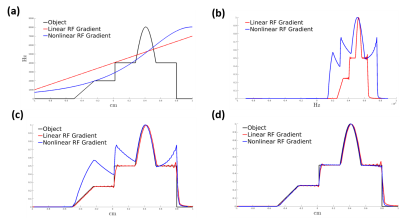Paul Wang1, Michael Mullen2, Lance DelaBarre2, and Michael Garwood2
1Center for Magnetic Resonance Research and Department of Biomedical Engineering, University of Minnesota, Minneapolis, MN, United States, 2Center for Magnetic Resonance Research and Department of Radiology, University of Minnesota, Minneapolis, MN, United States
1Center for Magnetic Resonance Research and Department of Biomedical Engineering, University of Minnesota, Minneapolis, MN, United States, 2Center for Magnetic Resonance Research and Department of Radiology, University of Minnesota, Minneapolis, MN, United States
Image
distortions in RF-encoded MRI can be corrected by modeling the
spatially-dependent B1 field of the RF transmitter coil as
a sum of linear and nonlinear components, and adapting a
mathematical framework used to correct image distortions arising from B0
nonlinearity in standard MRI.

Figure 1: Illustration of nonlinearity arising from B1 gradients. (a) Standard
MRI phase encoding gradients are built to be linear in amplitude and phase. (b)
Example nonlinear B1 gradient generated by single loop surface coil is
nonlinear in amplitude and phase.

Figure 3: Nonlinear RF gradient encoding leads to
geometric and intensity distortions in the image, which can be corrected. (a)
Numerical phantom plotted with linear and nonlinear RF gradients. (b) Fourier
reconstruction of Bloch simulation using linear RF gradient shows no distortions whereas nonlinear RF gradient
encoding does. (c) Geometric distortions are corrected using interpolation. (d)
Intensity distortion is corrected by Jacobian scaling.
